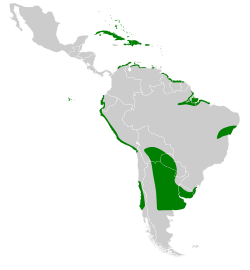| White-cheeked pintail | |
|---|---|
 | |
| Anas bahamensis bahamensis, South Abaco, Bahamas | |
| Scientific classification | |
| Kingdom: | Animalia |
| Phylum: | Chordata |
| Class: | Aves |
| Order: | Anseriformes |
| Family: | Anatidae |
| Genus: | Anas |
| Species: | A. bahamensis |
| Binomial name | |
| Anas bahamensis | |
| Subspecies | |
 | |
The white-cheeked pintail (Anas bahamensis), also known as the Bahama pintail or Bahama duck, is a species of dabbling duck that is patchily distributed throughout South America and the Caribbean. It was first described by Carl Linnaeus in his landmark 1758 10th edition of Systema Naturae under its current scientific name.









